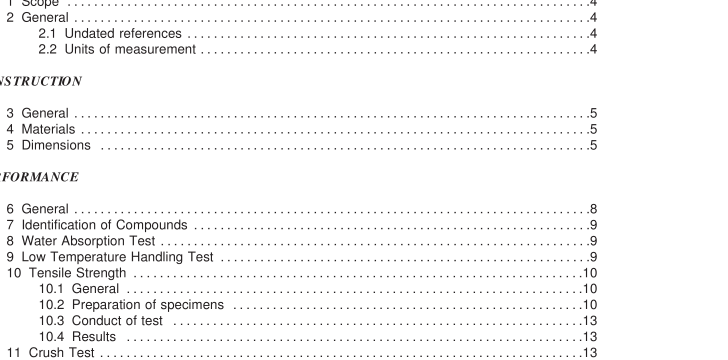UL 651B-2007 pdf download.Continuous Length HDPE Conduit.
5.3 The measurements from which the average outside diameters of a length of nished conduit are to be determined are to be made by means of a: a) Machinist’s micrometer caliper that has a at-ended spindle, a at anvil, and is calibrated to read directly to at least 0.001 inch or 0.01 mm; b) Vernier caliper calibrated to read directly to at least 0.001 inch or 0.01 mm; c) Vernier wrap tape, calibrated to read directly to at least 0.001 inch or 0.01 mm; d) Tapered sleeve gauge accurate to±1 percent of its taper and ±0.001 inch (±0.01 mm) of its diameter; or e) Sleeve window gauge accurate to within ±1 percent of its tape and ±0.001 inch of its diameter. 5.4 When differences arise between measuring techniques, the vernier wrap tape is to act as the referee for determining compliance with the requirements for average outside diameters. 5.5 When employing a tapered sleeve gauge, the entrance and exit diameters of the gauge shall correspond to the maximum and minimum outside diameters for the trade size of conduit being measured. 5.6 When employing a sleeve window gauge, the window shall extend beyond the two scribed marks which shall represent the minimum and maximum permitted diameters. 5.7 The measurements from which the minimum and maximum outside diameters of nished conduit are to be determined are to be made by means of: a) A machinist’s micrometer caliper that has a at-ended spindle, a at anvil, and is calibrated to read directly to at least 0.001 inch or 0.01 mm; b) A vernier caliper calibrated to read directly to at least 0.001 inch or 0.01 mm; or c) An out-of-roundness gauge accurate to 0.001 inch or 0.01 mm.
5.11 To determine the average outside diameter when using a micrometer caliper or vernier caliper, at least four measurements (every 45 degrees) are required at each location to make certain that the largest and smallest diameters are found. The average of all the recorded diameters is to be determined for the trade size of conduit involved. The average of the recorded diameters shall not differ from the average diameter in Table 5.1 by more than the specied tolerances. 5.12 To determine the average outside diameter when using vernier wrap tape, place the vernier wrap tape around the conduit making sure that it is at right angles to the conduit axis and is at against the conduit surface. The observed reading shall not differ from the average diameter in Table 5.1 by more than the specied tolerances. 5.13 To determine the average outside diameter when using a tapered sleeve gauge or sleeve window gauge, cut the end of the conduit square and remove burrs. Insert the conduit into the sleeve gauge and observe the position of the end with respect to the ends of the tapered sleeve gauge or the position of the end with respect to the minimum and maximum scribed marks of the sleeve window gauge. 5.14 When using a tapered sleeve gauge, the end of the conduit shall enter the largest end of the gauge and shall not pass through the smaller end of the gauge. 5.15 When using a sleeve window gauge the end of the conduit shall be visible between the two scribed marks when the conduit is inserted into the gauge. 5.16 The average of all of the recorded diameters is to be determined for the size of conduit involved. The average of the recorded diameters shall not differ from the average diameter in Table 5.1 by more than the specied tolerances. 5.17 The wall thickness is to be measured at one or both ends of the conduit by means of the caliper with the hemispherical anvil. At least four measurements are required at each end measured to make certain that the thickest and thinnest parts of the wall are found. UL 651B-2007 pdf download.
UL 651B-2007 pdf download
